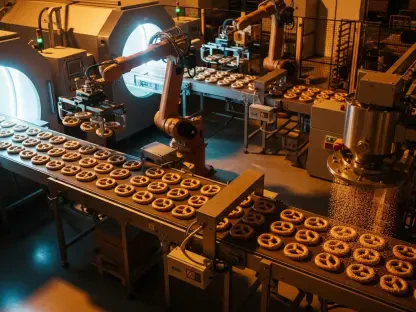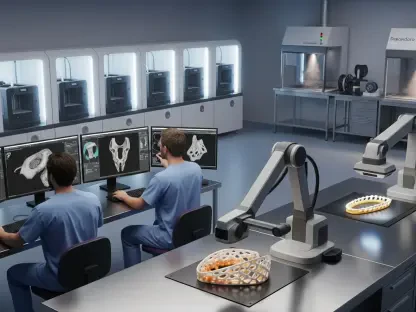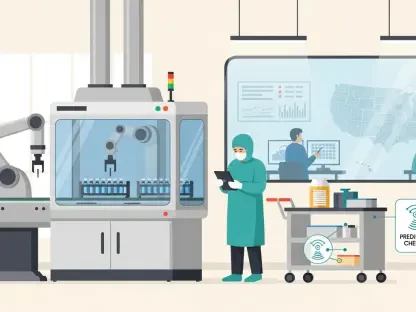In an era where biomanufacturing space in the U.S. is seeing unprecedented demand, Kwame Zaire brings a unique perspective to the conversation. As an expert in manufacturing, electronics, and equipment, Kwame has an intricate understanding of production management and predictive maintenance, and his insights into the life sciences sector shed light on current trends and challenges. With a 185% increase in demand for biomanufacturing space and significant moves by global pharmaceutical companies to invest in the U.S., Kwame explores the driving forces behind these developments and the broader implications for the commercial real estate market in life sciences.
What are the main factors driving the 185% increase in demand for biomanufacturing space in the U.S. over the past six months?
The surge in demand is predominantly driven by large pharma companies and CDMOs that are eager to enhance their domestic operations. One of the significant factors is the desire to fortify the supply chain in the face of geopolitical uncertainties and to secure patent and data. Recent economic and policy shifts, combined with the global need for reliable and localized production, have incentivized these companies to expand their footprint on U.S. soil.
Can you explain how the Trump administration’s threat of pharmaceutical tariffs has influenced big pharma companies to increase their U.S. investments?
The Trump administration’s tariff threat was indeed instrumental. It put a spotlight on the risks of relying heavily on international supply chains. By imposing potential tariffs, it pushed companies to curtail these risks and catalyze new investments within the U.S. Pharmaceuticals now recognize the strategic advantage of a more localized manufacturing base to hedge against international trade volatility and enhancing their capabilities on domestic grounds in response.
Which major pharma companies have announced significant U.S. biomanufacturing and R&D investments, and how much are they planning to invest?
Several of the world’s largest pharma companies, including AbbVie, Bristol Myers Squibb, and Eli Lilly, among others, have committed to substantial U.S. investments. Collectively, these investments exceed $270 billion over the next five to ten years. It shows a strong confidence in the U.S. market from both a strategic and financial perspective, particularly concerning biomanufacturing and R&D capabilities.
How are geopolitical factors and concerns about the supply chain affecting the demand for domestic pharma manufacturing?
Geopolitical tensions often lead to uncertainties in global supply chains. Issues such as trade disputes, tariffs, and import restrictions can have direct consequences on the timely availability of pharmaceuticals. These factors compel companies to re-evaluate their supply chain strategies and increasingly focus on domestic manufacturing to ensure stability and reliability in their production processes, mitigating risks associated with external dependencies.
Why is the U.S. a focal point for pharmaceutical reshoring, and how does its role as the world’s biggest importer of pharmaceuticals play into this?
As the world’s largest importer, the U.S. naturally becomes a focal point for reshoring due to its vast market size and consumption capabilities. Companies see opportunities not only to cut costs related to tariffs and transportation but also to be closer to a significant base of their customers. The notion of a stable, localized supply chain aligns well with long-term strategic objectives, ensuring reliable access to the U.S. market.
What are the reasons behind the decline in U.S. lab leasing volume in the first quarter of 2025?
The decline is largely a manifestation of macroeconomic and policy uncertainties. Companies within life sciences are adopting more cautious approaches as they navigate these uncertainties. They are reevaluating their real estate commitments, which affects leasing volumes. Potential cutbacks in public funding and investor hesitancy also contribute to the slowdown, pushing firms to adopt conservative real estate strategies.
How have macroeconomic, policy, and funding uncertainties impacted life sciences companies’ real estate decisions?
These uncertainties have undoubtedly led to more conservative decision-making processes. Companies are weighing the risks associated with long-term commitments in the face of potential economic downturns or regulatory shifts. Consequently, their real estate strategies reflect a pragmatic approach, prioritizing flexibility and cost-efficiency to stay agile in an evolving landscape.
What steps are needed to bring the U.S. lab market back to equilibrium, and how much space would need to be absorbed to achieve this balance?
To reach equilibrium, the U.S. lab market needs a substantial net absorption of space. The report indicates between 20 million and 25 million square feet needs to be absorbed. This could be through increased leasing activity or significant reductions in supply. Encouraging more tenant occupancy, perhaps through policy incentives or by adapting existing spaces to meet current market demands, could help expedite this return to balance.
Can you discuss the challenges faced by buildings with elevated vacancy levels in the U.S. lab market, and how these buildings are adapting?
Buildings with high vacancy rates face the urgent need to repurpose or find alternative uses to remain viable. Many are exploring conversions to different functions, such as office spaces or other commercial uses. This comes as a necessity to maintain profitability and avoid financial strain, which has been exacerbated by the current oversupply situation. This adaptability is crucial for owners to mitigate losses and preserve their assets’ value.
How are specific U.S. markets, such as Boston, the San Francisco Bay Area, and San Diego, handling the prolonged lab space oversupply, and how is this impacting rent prices?
These pioneering markets are experiencing challenges due to continued oversupply, which sustains pressure on rent prices. Tenants are in a favorable position to negotiate lower rents, forcing landlords to offer competitive pricing or enhanced lease terms. Despite their historical strengths in the life sciences sector, these markets must now balance supply and demand to stabilize and maintain their economic vitality.
What distinguishes midsize markets like Greater Washington, D.C., New Jersey, and Raleigh-Durham in terms of lab space availability and rent changes?
Midsize markets maintain stronger stability compared to larger hubs due to moderate supply and demand dynamics. They continue to provide attractive options for companies looking to avoid the intense competition and pricing of larger markets. Their relative availability and affordability make them appealing for new and expanding life sciences ventures that still require robust infrastructure without the higher costs.
Why is the Los Angeles lab market considered an outlier, and what factors contribute to its rent growth?
The Los Angeles lab market stands out for its low availability rates, which drive rent growth. The constrained supply paired with high demand allows landlords to command higher rents. Its geographically fragmented nature limits the potential for substantial increases in available space, making it a competitive environment for tenants looking to secure necessary lab facilities.
Do you have any advice for our readers?
Diversification remains key. Whether in investment or expansion strategy, having a diverse portfolio and flexible approach can buffer against unexpected shifts in market dynamics. Staying vigilant about geopolitical changes and embracing predictive maintenance and quality controls are also critical for sustaining long-term growth in this evolving industry landscape.









